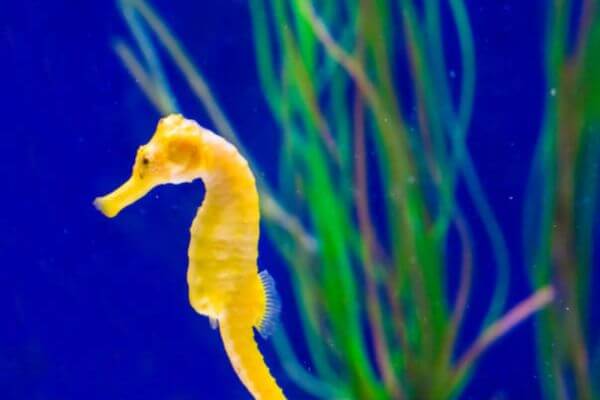Seahorses are fascinating and mysterious creatures that play essential roles in marine ecosystems. Although they often go unnoticed, these small animals have a significant impact on the health and balance of the oceans.
In this article, we will explore their importance as bioindicators, predators, pollinators and guardians of coral reefs. In addition, we will discuss the negative effects of the absence of these creatures, highlighting the need to protect and preserve these invisible heroes of the oceans.

Seahorses as bioindicators
Seahorses play a significant role as bioindicators of the health of coastal ecosystems. Their presence or absence can provide valuable insights into the environmental quality of these areas. These fragile creatures are sensitive to changes in habitat conditions such as pollution, habitat degradation and changes in food availability.
By monitoring populations of these marine animals, scientists can assess the overall health of coastal ecosystems and identify potential environmental issues. For example, a sharp decrease in seahorse populations could indicate pollution or habitat loss, calling attention to the need for measures to conserve and protect these vital ecosystems.
Where do seahorses fit in the ecosystem?
Seahorses play an important role in the food chain of marine ecosystems. They are considered ambush predators, feeding mainly on small crustaceans and small fish. Their tube-shaped mouth allows them to suck in their prey with precision. As predators, they help control the population of their prey, playing a role in the balance of species within the ecosystem. Furthermore, when they are hunted by larger predators, they become part of the food chain, transferring energy and nutrients to higher trophic levels.
At the same time, they are also prey for other marine animals, such as larger fish and seabirds. Their presence in the food chain not only provides food for predators, but also plays a role in balancing predator and prey populations within the marine ecosystem. Therefore, understanding where seahorses fit in the food chain is critical to understanding the complexity and interconnectedness of living things in marine ecosystems.
Underwater pollinators
Seahorses play a unique role as underwater pollinators and make a significant contribution to the reproduction of aquatic plants. In certain species, males have a structure called an incubator bag, where fertilized eggs are deposited by females. During this period, males provide protection and oxygenation to the developing embryos. At the time of hatching, the hatchlings emerge from the brood pouch as small copies of the adults.
During the reproduction process, males can carry the fertilized eggs over long distances while moving through the aquatic environment. This makes them efficient agents of gamete dispersion and pollination of aquatic plants. When swimming between different areas, they carry with them the genetic material necessary for the reproduction of aquatic plants, helping in the genetic diversity and sustaining these plant populations. Therefore, they play a vital role in the reproduction and life cycle of aquatic plants, contributing to the preservation and balance of marine ecosystems.
Guardians of Coral Reefs: The Symbiotic Relationship Between Seahorses and Corals
Seahorses play an important role as guardians of coral reefs due to their symbiotic relationship with these ecosystems, as they depend on coral reefs as a habitat for shelter and camouflage from predators. In turn, they provide benefits to corals by acting as pollinators and dispersers of genetic material.
As seahorses move between reefs, they transport pollen and gametes from different coral colonies, aiding in the genetic diversity and reproduction of coral species.
In addition, they can also help protect corals by feeding on small organisms that can harm coral growth and health, such as small crustaceans and shrimp. This beneficial interaction reinforces its importance in the preservation of coral reefs and in the balance of these ecosystems.
Efficient Predators: Controlling Populations of Small Marine Organisms
Seahorses are efficient predators that play a crucial role in controlling populations of small marine organisms. Their unique anatomy, such as their elongated, tube-like snout, allows them to perform precise ambushes and capture prey efficiently. They feed mainly on small crustaceans such as shrimp and copepods, as well as fish larvae and other marine microorganisms.
By controlling populations of small marine organisms, they play an important role in maintaining the ecological balance in marine ecosystems. By reducing the abundance of certain prey, they help control the uncontrolled growth of these organisms, thus preventing possible negative effects on the food chain and the ecosystem as a whole. Their presence as efficient predators is essential to ensure the health and sustainability of marine habitats.
Mimicry and camouflage
Seahorses play a vital role in protecting the ecosystem through many factors, such as:
- Camouflage and mimicry: These marine animals are masters of the art of camouflage and mimicry, adapting their appearance to blend seamlessly with their environment. Their textured skin and variable coloration allow them to resemble marine plants, corals and other elements in the environment, making them nearly invisible to predators and prey alike.
- Protection from Predators: The use of camouflage plays a vital role in protecting the ecosystem, allowing them to hide from potential predators. By camouflaging themselves, they can avoid detection and thus lower their chances of being hunted. This is especially important as seahorses prey on animals such as larger fish and seabirds.
- Contribution to ecological balance: By merging with the environment, they can hunt their prey more efficiently, ensuring control of populations of small marine organisms. Furthermore, their camouflage protects them from being detected by predators, allowing them to continue to play their role as efficient predators and maintaining the balance of food chains in marine ecosystems.
- Preservation of diversity: The camouflage of seahorses also contributes to the preservation of the diversity of the marine ecosystem. By camouflaging themselves, they avoid detection by predators and can live in different ecological habitats. This increases the diversity of species and habitats within the ecosystem, promoting the stability and resilience of the marine environment.
- Influence on the behavior of other species: The camouflage of seahorses can have an impact on the behavior of other marine species. Their presence can affect the behavior of predators and prey, influencing the distribution and movement of these species in the ecosystem. This indirect interaction has cascading effects on the ecosystem as a whole, affecting population dynamics and interconnectedness between species.
Balancing the marine ecosystem
The absence of seahorses can have several negative effects on marine ecosystems:
- Population imbalance: Play a role in controlling populations of small marine organisms such as shrimp and crustaceans. Without seahorses as efficient predators, these populations could grow out of control, causing imbalances in the food chain and negatively affecting other species.
- Impact on coral reefs: They have a symbiotic relationship with corals, providing benefits to corals and assisting in their reproduction. The absence of seahorses can have an impact on the health and diversity of coral reefs, affecting the reproduction and sustainability of these marine ecosystems.
- Loss of bioindication capacity: They are considered bioindicators of the health of coastal ecosystems. Its absence makes it difficult to monitor and detect environmental problems, such as pollution and habitat degradation. Their lack as indicators can result in delays in identifying and solving environmental problems.
- Less genetic diversity: Play a role in dispersing genetic material, transporting pollen and gametes between different colonies of corals and aquatic plants. The absence of seahorses may result in lower genetic diversity in aquatic plant and coral populations, reducing their adaptability and resilience to environmental changes.
- Missed opportunities for study and research: Seahorses are objects of scientific study, providing valuable insights into reproduction, behavior and marine ecology. The absence of these marine beings limits opportunities for research and understanding of ecosystems in the oceans, hindering the advancement of scientific knowledge in this area.
All in all, seahorses are fascinating creatures and play essential roles in marine ecosystems. Their presence influences the health and balance of the oceans, acting as bioindicators, predators, pollinators and guardians of coral reefs. The absence of these invisible heroes can lead to population imbalances, impacts on coral reefs, loss of bioindication capacity, lower genetic diversity and limitations in scientific research.
So it isit is fundamental to protect and preserve them, recognizing their importance in maintaining the sustainability of marine ecosystems and ensuring a healthy future for the oceans.

